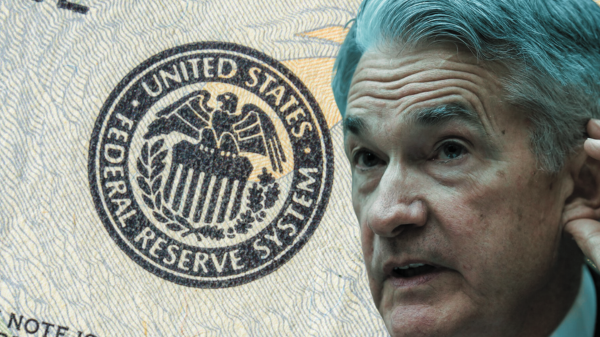Federal Reserve’s economic damage is far from over, as fake growth is about to end, to be replaced by a painful recession. (Commentary)
The Federal Reserve announced last week it would continue its pause in interest rate increases, and the federal government’s monthly national jobs report showed a significant decline in hiring. Unfortunately, the job-creation slowdown is exactly the sort of damage the central bank intends to continue to do to the economy.
It’s important to note, however, that the Fed’s policies result from the central bank’s attempts to deal with enormous and wasteful federal government spending. Congress and presidents are to blame for the nation’s mounting economic troubles.
U.S. employers added barely half as many jobs in October compared with September, well below the trend line for the previous quarter. The unemployment rate rose to 3.9%, up from 3.8% in September.
Fully one-third of the new jobs were in government, however, meaning a much higher proportion of the meager employment growth in October occurred outside the private sector. The leading job-adding sector was health care, which the government heavily finances. Private sector employment is growing even more slowly than the overall employment numbers suggest.
In further bad news for people who work for a living, wage growth slowed from an annual rate of 4.3% to 4.1%.
The cause of the slowdown is obvious: that “the economy is cooling” because of “higher borrowing costs following the Federal Reserve’s interest-rate increases earlier this year,” The Wall Street Journal reported.
The Federal Reserve took this “cooling” as good news, as is its habit and was its intention, and the stock and bond markets responded accordingly. “Investors were hoping for an easing of job gains as a sign that the economy is slowing and the Fed can stop tightening,” the Journal said.
The tepid job numbers show the economy slowed in October after gross domestic product grew at a 4.9% annual rate in the third quarter. Business activity surveys confirm this, showing a long-term contraction in manufacturing and an ongoing decline in service business.
Much of the recent GDP growth has not been via the production of goods and services but a result of greater indebtedness. Government spending has increased rapidly, reaching record highs, and it is being financed by massive new debt.
Consumers are likewise borrowing more. Household debt hit a record $17.29 trillion in the third quarter, and credit card debt reached a record $1.079 trillion after the eighth consecutive quarter of year-over-year increases, the New York Fed reported.
Excess money the Fed created to finance a government spending spree from March 2020 through March 2023 has pushed up measured GDP despite the stagnation in the production of goods and services.
It appears that this fake growth is about to end, to be replaced by a painful recession. There is a significant time lapse between monetary tightening and its effects on the overall economy, as the excess money in the economy continues to fuel both production and consumption while it lasts.
The enormous annual increase in the money supply of 16.5% from March 2020 to March 2022 flooded the economy with cash and sparked rapid inflation. In a panic, the Fed hit the brakes hard and reversed course. The Fed’s actions since March of last year have tightened the money supply measure by 3.9%, “the most extreme contraction since 1933,” said Johns Hopkins fellow John Greenwood and Johns Hopkins University professor Steve H. Hanke at the Journal.
“The money supply has been contracting for 18 months, and soon, after the overhanging extra money from 2020-21 has been used up, spending will plunge and inflation will fall, not simply to 2%, but below — and perhaps even into deflation in 2025,” Mr. Greenwood and Mr. Hanke wrote.
The tsunami of money is receding fast, and that will lead to contractions of investment and consumer spending.
The Fed is certainly responsible for its part in this series of economic problems. It is important, however, to recognize that the root of all the trouble is federal overspending. Congress and President Biden indulged in an enormous increase in government largesse in an already strong economy when such spending increases are wasteful and inflationary.
The Fed provided the money for this reckless overspending, but it hardly had a choice in the matter. Tightening the money supply or even keeping it stable would have brought on an immediate deflation and awful recession. As Angelo State University professor Bryan Cutsinger said, “it is the central bank’s willingness to help finance government spending, not the spending itself, that drives inflation.”
True: The Fed’s choice was between an immediate, harsh recession, a depression, and a recession after a bout of inflation. The central bank generally chooses the latter in the hope of a soft landing that virtually always proves impossible.
If we do get a recession, as I expect, the Fed will stamp on the monetary accelerator, cheapen the dollar, and start a new round of boom and bust. The Fed will, of course, be responsible for that choice, but the real culprits behind the inflation-recession roller coaster are Congress, the president, and the people who voted them into office.
S.T. Karnick is a senior fellow and director of publications for The Heartland Institute, where he edits the Heartland Daily News and writes the e-newsletter Life, Liberty, Property.
Originally published by The Washington Times. Republished with the author’s permission.
For more Budget & Tax News.











